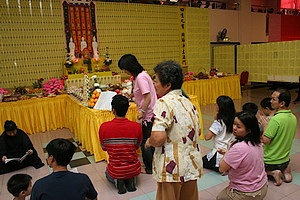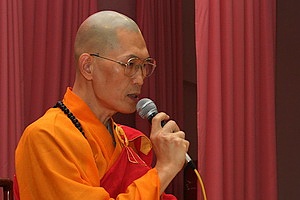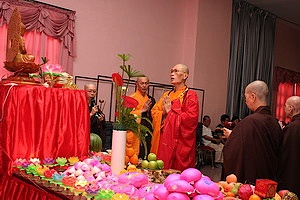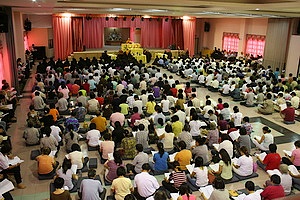Submitted by Ah Jin on
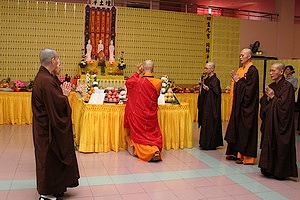
In conjunction and in commemoration of the annual Buddhist festival of Ulambana, Than Hsiang temple held a filial piety dharma assembly on 17 August at 9.30am at the 5th floor multi-purpose hall. The festival and the assembly promoted and high lighted the tradition and virtue of gratitude and filial duty.
Prior to the day of assembly, the temple held cultivation sessions - the chanting of the Amitabha sutra and Amitabha name recitation, for six consecutive nights (11 to 16 of the seventh month of lunar calendar). During her brief dharma sharing session on the night of the 15th of the 7th lunar month, Ven. Zhen Xin gave a synopsis of the story of Mongallana’s rescue of his mother to explain the meaning of the “Ulambana sutra”.
In fact, the preparation work for the assembly commenced two months ahead which comprised the publicity, collection of donations, registration and arrangement and placement of cards with registered names of the deceased and sponsors on the altar walls.
More than a thousand devotees attended the solemn and serene assembly. The event began with the cleansing ritual of sprinkling the holy water by Ven. Zhen Ru, followed by the chanting of the great compassion sutra, Amitabha name recitation and the great offering to the Buddha. The 1st of the “three –session dharma recitation” began at 1.00pm after lunch.
The three-session chanting constitutes one of unique method of cultivation of the Pure- land sect. Ven. Cung Fong, the chief abbot during the Yuan dynasty in China, introduced and promoted the method, specializing in Buddha name chanting to gain liberation. By relying in the faith in Amitabha’s great vows, the chanting help to transfer merits to the deceased to enable them to be born in pure land, thus transcending the cycle of birth and death. However, the chanting session is more beneficial for the living as it serves to strengthen one’ resolve on the path of bodhicitta and ultimately attained enlightenment.
Each session of the triple-chanting session consists of seven sections namely: sutra chanting, Buddha name recitation, dharma sharing, resolution of wholesome deed, repentance and lastly chanting in praise of the Buddha.
Participants also took the opportunity to request blessings from the compassionate Buddha and bodhisattva to resolve or settle any outstanding grievances with their so- called karma creditors.
At end of the 1st session, the presiding monk proceeded to explain the origin of the filial piety dharma assembly in the context of Ulambana sutra, while emphasizing that 15th day of the 7th lunar month has nothing to with the customary “ghost festival” but represent instead a day earmarked as “Buddha joyous day” or “sangha reflection day”.
What are “Buddha joyous day and sangha refelection day”?
Well, in ancient India, during the Vassa months of raining season, monks are prohibited from traveling for three months other than dharma preaching or attending to their parental care. One of the reasons is to avoid causing harm to insects or living organism by accidentally stepping on them. Therefore, during the 3-month period of Vassa, monks would spend their time on cultivation indoors .At end of the period, some monks might attain 1st, 2nd, 3rd or even the 4th stage of sainthood. The final day of the Vassa is thus name the day of “Buddha joyous day” in respect of their various degree of enlightenment. For those without attainment, the day is name the day of reflection. That explained their origins.
At end of the third session, the name cards bearing names of the deceased pasted on the altar walls were taken down to the ground floor to set ablaze, amidst the chanting/blessings by the sangha members. This marked the end of dharma assembly, symbolizing the completion of meritorious deeds by the participants, and a sincere wish for all sentient beings to seek liberation from suffering.
Once again, another successfully completion of a filial piety dharma assembly with the blessing from all concerned. Lastly, the proceeds collected from the assembly were channeled towards the Phor Tay education/building fund.
